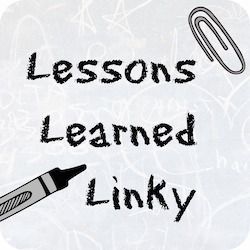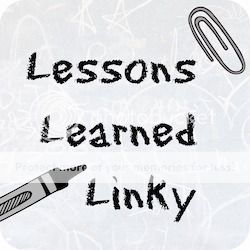Welcome to the April installment of Lessons Learned Linky, where I encourage you to share your tutorials, discoveries, and revelation-inducing mishaps so that we can all learn from each other.
I learned some really useful things from my fellow quilters this past month.
Anne at Hudson Valley Quilts explained why updating your quilting rulers may be a good idea in her first installment of a four part series on measuring skills quilters can't live without. Like her, I have a
huge square ruler (affiliate link), and love it.
Julie at Pink Doxies made an excellent point about how the weight of your embroidery floss can impact the ease of hand quilting.
Jennifer at The Inquiring Quilter gives some tips about making rag quilts.
Juliet at The Tartan Kiwi discussed how the scale of a fabric print can impact your quilt. I'll be pattern testing her seahorse pattern. So awesome!
Kitty at Night Quilter shared some of her favorite finishing tools and techniques. I use self-threading needles, and have the Hera marker on my shopping list now.
Beth at Cooking Up Quilts gave me the idea to use gripper pads for gripping a quilt during free-motion. I tried this, and can attest that it worked really well.
Yvonne at Quilting Jetgirl explained
how to use tailor's tape as a straight line reference when long-arming and
how to add a subtle detail to binding.
Jayne at Twiggy and Opal proved to me that sometimes we are our own worst critics, and often our mistakes could easily go unnoticed by others.
Julie at The Crafty Quilter has a wonderful video and tutorial on using machine embroidery stitches when appliquéing. I, for one, underutilize my decorative stitches, and can benefit from her expertise.
Lesson Learned
This month I realized a few things about free-motion quilting. First, it's a good idea to do some mental calculating about how long it takes you to do a particular free-motion motif (say, pebbles, for instance) before you commit to an entire background of that design. Secondly, while using a matching thread color may create lovely thread texture while deemphasizing bobbles, it simultaneously hides the thread
as you quilt with it. This makes it awfully hard to tell where you've been, and where you are going.
- By sharing here, you give me permission to feature your post on Quilting Mod (including a photo) with proper attribution and a link to the original.
- Spread the comment love.
- Link back to this post. I have a button you can grab below.
- Multiple posts are fine so long as they are from this month.
At the end of the month, one lucky linker will win two fat quarters of Flock Together by Kathy Doughty for FreeSpirit Fabric.
Update: KatyQuilts is the winner!
Grab the Button:




































